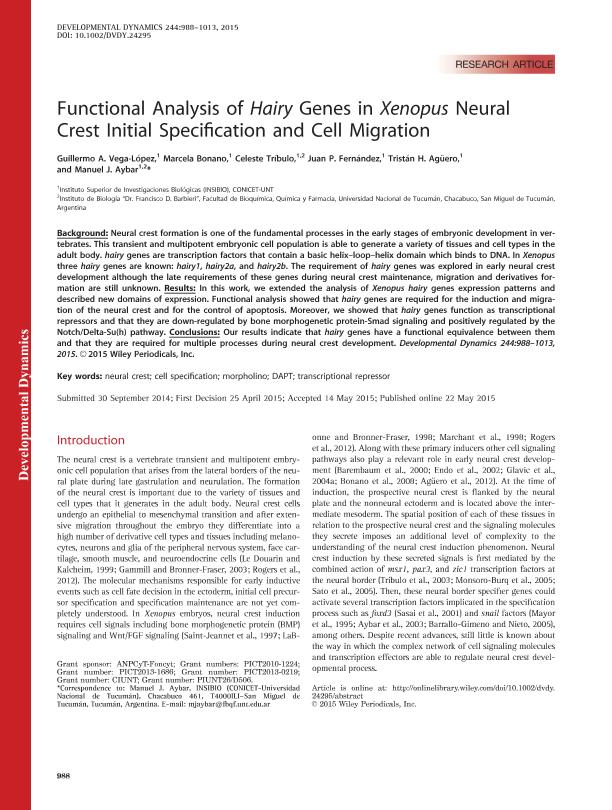Artículo
Functional analysis of Hairy genes in Xenopus neural crest initial specification and cell migration
Vega López, Guillermo Alfredo ; Bonano, Marcela
; Bonano, Marcela ; Tríbulo, Celeste
; Tríbulo, Celeste ; Fernández, Juan Pablo
; Fernández, Juan Pablo ; Aguero, Tristán H.; Aybar, Manuel Javier
; Aguero, Tristán H.; Aybar, Manuel Javier
 ; Bonano, Marcela
; Bonano, Marcela ; Tríbulo, Celeste
; Tríbulo, Celeste ; Fernández, Juan Pablo
; Fernández, Juan Pablo ; Aguero, Tristán H.; Aybar, Manuel Javier
; Aguero, Tristán H.; Aybar, Manuel Javier
Fecha de publicación:
08/2015
Editorial:
Wiley-liss, Div John Wiley & Sons Inc
Revista:
Developmental Dynamics
ISSN:
1058-8388
Idioma:
Inglés
Tipo de recurso:
Artículo publicado
Clasificación temática:
Resumen
Background: Neural crest formation is one of the fundamental processes in the early stages of embryonic development in vertebrates. This transient and multipotent embryonic cell population is able to generate a variety of tissues and cell types in the adult body. hairy genes are transcription factors that contain a basic helix–loop–helix domain which binds to DNA. In Xenopus three hairy genes are known: hairy1, hairy2a, and hairy2b. The requirement of hairy genes was explored in early neural crest development although the late requirements of these genes during neural crest maintenance, migration and derivatives formation are still unknown. Results: In this work, we extended the analysis of Xenopus hairy genes expression patterns and described new domains of expression. Functional analysis showed that hairy genes are required for the induction and migration of the neural crest and for the control of apoptosis. Moreover, we showed that hairy genes function as transcriptional repressors and that they are down‐regulated by bone morphogenetic protein‐Smad signaling and positively regulated by the Notch/Delta‐Su(h) pathway. Conclusions: Our results indicate that hairy genes have a functional equivalence between them and that they are required for multiple processes during neural crest development.
Palabras clave:
Neural Crest
,
Cell Specification
,
Dapt
,
Transcriptional Represor
Archivos asociados
Licencia
Identificadores
Colecciones
Articulos(INSIBIO)
Articulos de INST.SUP.DE INVEST.BIOLOGICAS
Articulos de INST.SUP.DE INVEST.BIOLOGICAS
Citación
Vega López, Guillermo Alfredo; Bonano, Marcela; Tríbulo, Celeste; Fernández, Juan Pablo; Aguero, Tristán H.; et al.; Functional analysis of Hairy genes in Xenopus neural crest initial specification and cell migration; Wiley-liss, Div John Wiley & Sons Inc; Developmental Dynamics; 244; 8; 8-2015; 908-1013
Compartir
Altmétricas



